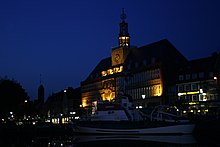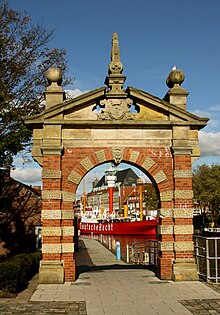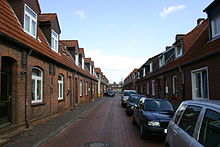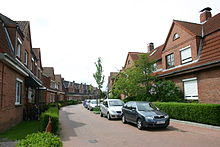Buildings in the city of Emden
The city of Emden in East Friesland lost a large part of its historical building stock due to heavy bombing during World War II.
As a landmark of Emden, the town hall (if it is even after the destruction of war to a new building) and the port gate apply from earlier centuries. The water tower and the gantry crane of the North Sea Works are to be mentioned from the industrial age .
Public buildings


The Emden town hall was originally built in 1574–76 by the Antwerp city architect Laurens van Steenwinckel. After almost complete destruction in World War II , it was rebuilt in a modern form, taking up some elements of the previous building. Parts of the ground floor masonry were included. Emden's motto is written on the masonry above the entrance at the front: “Concordia res parvae crescunt” (“Small things grow through harmony”). The town hall now houses the East Frisian State Museum .
The harbor gate was built in 1635 by the Emden city architect Martin Faber . It is one of several artistically significant city gates that were built in the first half of the 17th century - and the only one that has survived. However, several restorations have been carried out over the centuries, so that the current condition shows the original condition, but no longer has any original materials. On the archway is the Latin saying "Et pons est Embdae et portus et aura deus" ("God is for Emden bridge, harbor and sailing wind").
The New Church of the Evangelical Reformed Congregation was built between 1643 and 1648 by the Emden city master builder Martin Faber. It is modeled on the Noorderkerk in Amsterdam .
The Realschule am Herrentor, a building that is more than 75 years old and which has been home to one of the first Realschule in the region for fifty years, is now a listed building. It was built in the clinker renaissance style. Likewise the old Apollotheater (cinema), the old AOK building opposite and the so-called Chinese temple.
The Pelzerhäuser are located on Pelzerstraße in the old town of Emden . Pelzerhaus 11 is a three-storey residential building built in 1909 based on the previous building from the 16th century with re-used original parts. At Pelzerhaus 12, built in the second half of the 16th century, only the three-storey brick facade with volute gable remains. The associated house was replaced by a new building in 1983. They are among the oldest houses in the city.
The Gödensian house at Friedrich-Ebert-Straße 1–3 is a two-story brick house in a bacon layer system with a younger hip roof . It was built in 1551, making it one of the oldest buildings in Emden and has served as a student residence since 1985.
In the old town are the remains of the Great Church , which was destroyed in World War II. After the war it received a new bell tower through donations from Switzerland and has therefore been called the Swiss Church since then . In the 1990s the church was given modern parts and renovated. In 1995 the Johannes a Lasco library was opened there.
The art gallery in Emden was opened on October 3, 1986 by the then Federal President Richard von Weizsäcker . The museum's collection focuses on New Objectivity and German Expressionism, including works by Ernst Ludwig Kirchner, Max Pechstein and Emil Nolde.
Around the Schweckendieckplatz in the administrative district there are several office buildings that were built at the beginning of the 20th century, including the Haus der Schifffahrt , which housed the Stinnes subsidiary WTAG and the shipping brokerage Gütercontor Junge & Co.
There are also three floating structures in the Emder Ratsdelft . The lightship Amrumbank , the rescue cruiser Georg Breusing and the herring logger city of Emden . All three ships are open to the public and can be visited.
The Otto-Huus, opened in 1986, shows the career of the Emden-born comedian Otto Waalkes . In addition to curious childhood memories and props, excerpts from the comedian's events are shown.
Mills
See also: Emder mills
In the past, there were a number of mills in the city of Emden , most of which were Dutch mills . Some of them have been preserved, even if some of them have been converted.
The Dutch gallery De Vrouw Johanna from 1804 was restored in 1997 after the octagon burned down. The mill is located on a kennel of the Emden city wall and can be visited on request. Milling has been taking place again since 2004, as the mill is fully functional. The mill is looked after by the Emden Mill Association. A hostel was set up in the miller's former home. The location in the immediate vicinity of the Emden city moat - right next to a so-called paddle-and-pedal station - offers especially for cyclists and water hikers an overnight stay.
The Rote Mühle (built in 1795, alterations in 1823 and 1916) is also located on the Emder Wall. However, it no longer has wings and was rebuilt to its present condition between 1970 and 1973. A kindergarten is located there. The mill got its name from the red clinker bricks used in the construction.
The White Mill from 1810 is also on the Emder Wall . The wings were removed in 1952. The building is privately owned and in need of major renovation. However, a restoration has so far failed due to the unresolved financing and conflicting goals between monument protection and the intended use as a café. In 2006 the wooden octagon was taken down and it was dismantled in 2007 by the mill builder Möller. Some things, like the mill axis, parts of the wind rose, etc. a., stored in Jemgum. Much has since been sold on.
The Zeldenrust mill in the Tholenswehr district, a gallery Dutchman from 1807, was converted into a residential building in 2000. This also applies to the nacelle. It no longer has wings either.
The gallery Dutchman Kost Winning (in German: Broterwerb) in the Larrelt district of Emden was built in 1732. The mill is maintained by the Larrelter Dorfverein eV, which runs a tea room here. The mill is fully functional, there is a grinder and, since 2009, a sifter .

Technical buildings

The gantry crane of North Sea works can be seen from afar. The orange-colored structure with a load capacity of up to 400 tons is now one of Emden's landmarks - in this case one from the industrial age.
The 42 meter high Emden water tower , an Art Nouveau building near the train station, was built at the beginning of the 20th century. It is owned by Stadtwerke Emden and is still in operation.
See also: Emden water tower
The television tower , located just a few hundred meters from the town hall in the Groß-Faldern district, towers over all buildings in the city center at 94 meters. It is not open to the public.
There are a number of hydraulic structures through the port and the many canals flowing through Emden . An outstanding and unique in Europe is the boiler lock , the only round chamber lock in Europe that connects four waterways. The lock, built in the 1880s, is a listed building and still fulfills an important function in the waterway network of Emden and East Frisia. It also fulfills an important function for drainage . Immediately next to the lock are the historical buildings of the lock keeper's house and the lock servant house.
The Large sea lock was at its opening in 1913 with a single length of 260 meters, the largest in the world. The facility, which forms the main entrance to the Emden harbor , is a listed building. In the 1880s the Nesserlander Schleuse was opened, the second access to the port.
The canals are crossed by a variety of bascule bridges and drawbridges . Among them are modern bascule bridges on the main roads, most of which are raised hydraulically . Some of the drawbridges, including those over the Ems-Jade Canal in the Wolthusen and Uphusen districts , are designed in the typical Dutch-northwest German style.
The Knock sewer and pumping station in the far west of Emden is the largest of its kind in Europe. It drains the Knockster Tief and thus large parts of Emden and the northern environs.
Town houses and residential buildings

After the severe destruction in World War II, only sparse remains of the historic residential buildings have survived. The best impression of the old Emden is given by the largely spared district of Klein-Faldern with its predominantly petty bourgeois houses. To be emphasized on individual buildings:
- Kranstrasse 63 . Two-storey gabled house with a bell-shaped gable marked in 1813. The actual body of the house is certainly older.
- Mühlenstrasse 37 . Two-storey gabled house from the 16th / 17th centuries Century, the facade was renewed around 1900.
- Mühlenstrasse 45 . Single-storey building from the 2nd half of the 16th century, the facade was blinded in 1811.
In the districts of Barenburg and in the administrative district there are residential buildings that can be assigned to clinker expressionism . Among them is the row house group at Ringstrasse 36–38 from the 1920s.
The streets Torumer Straße and Wilgumer Straße form the starting point for the development of the Port Arthur / Transvaal district , which began in the first decade of the 20th century. Many of the small, crouched buildings, typical of a workers' settlement , have largely been preserved in their original state. Similarly laid out streets in Port Arthur / Transvaal, however, fell victim to the bombing war and were rebuilt after 1945.
The district (colony) Friesland is a workers' settlement from the 1920s that still looks the same today, but has been renovated . The one to two-storey buildings have smaller garden plots that were previously (and in some cases still today) used as a secondary agricultural activity.
For a medium-sized town with a good 50,000 inhabitants, Emden has a fairly high number of high-rise buildings (defined here as buildings with eight or more floors). All were built between 1959 and the early 1970s, and almost all are residential buildings. Only the so-called medical high - rise in the Bentinkshof district primarily serves commercial purposes, in this case in the medical sector. The high-rise buildings are concentrated in the city center as well as in the borssum and Barenburg districts. The two largest residential buildings in East Frisia are located in Emden, the so-called glass palaces in Barenburg (high-rise blocks with eleven floors). The former union-owned real estate group Neue Heimat played an important role in the construction of most of the high-rise buildings in Emden . Since the mid-1970s, however, no new high-rise buildings have been built in Emden - probably also because in the meantime problems with the “social mix” in the neighborhoods had arisen in some of the districts.
Monuments and landmarks
- In the city garden not far from the town hall there is a memorial in honor of the former mayor Leo Fürbringer . It is laid out in the form of a fountain. Fürbringer, Lord Mayor from 1878 to 1913, made a great contribution to the expansion of the Emden harbor at that time.
- A memorial in honor of the former Postmaster General of the German Reich, Heinrich von Stephan , is located on Stephansplatz, which is named after him . Von Stephan, who was also the founder of the Universal Postal Union, attended the commissioning of the Emden Post and Telegraph Office in 1879 and was also present in 1882 when the first cable connection between Germany and the USA (from Emden to Coney Island / New York City ) was opened. The memorial was erected in 1896 at the suggestion of the then Lord Mayor Leo Fürbringer. It was initially located in front of the post office, but was later moved to Stephansplatz .
- At the junction of Bundesstraße 210 and Landesstraße 3 in the direction of Pewsum there is a monument in honor of the former district administrator (from 1885) of the former district of Emden, Heinrich von Weyhe. He had previously been a bailiff in Wittmund, Esens and Berum and had made a name for himself in building roads in East Frisia, especially in the Krummhörn . The monument stands at the northernmost point of Emden, in the Harsweg district , which was incorporated in 1945 , and was donated by Krummhorn citizens.
- In honor of Carl Schweckendieck (1843–1906), a Prussian member of the state parliament from Emden, a memorial was erected on the square named after him. Schweckendieck, together with Mayor Leo Fürbringer, successfully campaigned for the construction of the Dortmund-Ems Canal and the expansion of the Emden port. The Schweckendieckplatz is located near the Ratsdelft, in an office district with shipping companies and administration buildings.
- The monuments of Frederick the Great and the Great Elector are located on the sewer and the Knock pumping station in the far west of Emden . Until the war they had stood opposite the town hall. In 1966 the city of Emden left the two monuments to the I. Drainage Association Emden, which maintains the system on the Knock. Both monarchs did a great job for East Frisia: the Great Elector by promoting sea trade in Emden, Frederick II by reclaiming moors and protecting the coast.
literature
- Hartwig Beseler , Niels Gutschow: War fates of German architecture. Loss, damage, rebuilding. Volume 1: Nord , Neumünster 1988, pages 235-247
- Heinrich Siebern: The art monuments of the city of Emden . (Inventories of art monuments in Lower Saxony, Volume 48). Reprint of the 1927 edition, Osnabrück 1980





